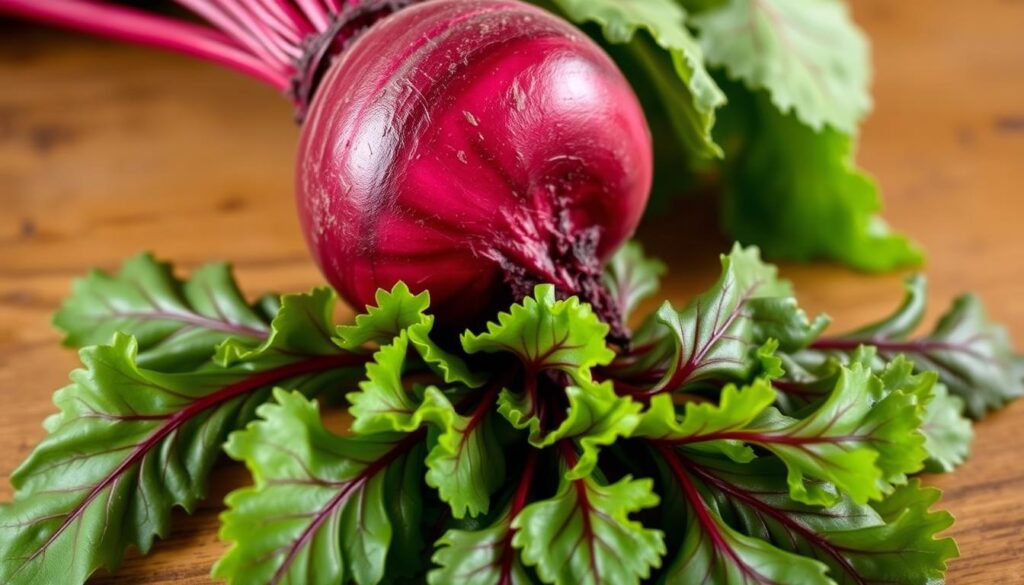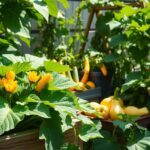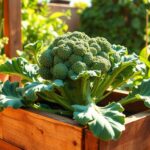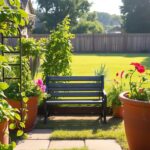Have you ever wondered if you can enjoy fresh, homegrown beet even if you don’t have a backyard? The answer is yes! Growing this vibrant vegetable in containers is not only possible but also incredibly rewarding. I’ve been doing it for years, and it’s become one of my favorite gardening activities.
Container gardening is a fantastic way to start your journey into growing your own food. It’s accessible, requires minimal space, and allows you to control the environment for your plants. Whether you’re a beginner or an experienced gardener, this guide will walk you through everything you need to know.
You might be asking, “Do beets grow well in containers?” Absolutely! With the right care, they thrive. I’ll share tips on choosing the best seeds, proper spacing, and watering techniques. Plus, I’ll cover harvesting and the nutritional benefits of homegrown beets. Let’s get started!
Key Takeaways
- Beets can thrive in containers with proper care and attention.
- Container gardening is beginner-friendly and space-efficient.
- Choose the right seeds and containers for optimal growth.
- Proper spacing and watering are key to healthy beet plants.
- Homegrown beets offer fresh, nutritious produce.
Selecting the Perfect Container for Beetroot
The success of your beet crop starts with selecting the perfect container. A well-chosen container ensures your plants have enough space to develop healthy roots. Let’s dive into the key factors to consider when picking the right one.
Understanding Container Size and 5-Gallon Bucket Capacity
The size of your container plays a crucial role in how many beets you can grow. For example, a 5-gallon bucket is a popular choice. It’s spacious enough to accommodate up to eight beets, provided you space them 3 to 4 inches apart. Larger options, like 15- to 20-gallon Smart Pots, are ideal for bigger harvests.
Determining the Right Depth for Healthy Root Growth
Depth is another critical factor. Your container should be at least 10 inches deep to allow the roots to grow properly. Shallow containers can restrict development, leading to smaller beets. I’ve found that hard-sided planters or fabric pots work best, as they provide ample room and excellent drainage.
Proper drainage is essential to prevent waterlogging. Adding a layer of pebbles at the bottom of your pot can help. This simple step ensures your beets stay healthy and thriving.
Prep Your Soil and Planting Essentials
Getting your soil and planting essentials right is the foundation of a thriving beet crop. A well-prepared setup ensures healthy roots and a bountiful harvest. Let’s break down the key steps to get started.
Soil Requirements and pH Considerations
Beets thrive in light, fluffy soil that drains well. I recommend amending your mix with compost or bone meal for added nutrients. The ideal pH level is between 6.0 and 7.0. If your soil is too acidic, adding limestone can help balance it.
Conducting a soil test is a simple way to check pH levels. You can find affordable kits at most garden centers. This step ensures your beets have the right environment to flourish.
Seed Preparation, Germination, and Spacing Techniques
Pre-soaking your seed pods for a few hours can improve germination. I’ve found this method especially helpful for faster and more consistent sprouting. Plant the seeds about an inch deep and space them 3 inches apart to give roots room to develop.
Using a prepackaged potting mix is a great option if you’re unsure about your garden soil. These mixes are designed to provide excellent drainage and prevent waterlogging. Adding perlite or vermiculite can further enhance aeration.
Once your seedlings emerge, thin them carefully to avoid disturbing established roots. This ensures each plant has enough space to grow. With these techniques, you’ll set the stage for a successful beet harvest.
How to Grow Beetroot in Pots with Confidence (grow beetroot in pots)
Sunlight and water are the two most critical factors for healthy beet plants. Whether you’re a beginner or an experienced gardener, mastering these elements will ensure a thriving crop. Let’s dive into the essentials of choosing the right spot and managing moisture effectively.
Choosing the Best Sunny Spot and Light Sources
Beets need six to eight hours of direct sunlight each day to thrive. If you’re growing indoors or during winter months, a reliable grow light can make all the difference. I’ve found that placing my containers near a south-facing window works wonders. For artificial lighting, a timer feature ensures consistent exposure, mimicking natural daylight.
Weather conditions also play a role. In hotter climates, partial shade during the hottest part of the day can prevent stress on your plants. Conversely, in cooler regions, maximizing sunlight exposure is key. Adjusting your setup based on the season ensures your beets stay healthy year-round.
Watering Guidelines and Overcoming Moisture Challenges
Proper watering is essential for a successful beet crop. The soil should stay moist but never waterlogged. I check the top inch of soil daily—if it feels dry, it’s time to water. Using a galvanized watering can allows for gentle, even distribution, preventing soil erosion.
Overwatering is a common mistake. It can lead to root rot and stunted growth. To avoid this, ensure your containers have proper drainage. Adding a layer of pebbles at the bottom helps excess water escape. During rainy weather, I move my pots to a sheltered spot to prevent over-saturation.
Consistency is key. Beets prefer steady moisture levels, so aim to water at the same time each day. With these simple steps, even novice gardeners can achieve a thriving crop. Remember, a little attention goes a long way in ensuring healthy, vibrant beets.
Troubleshooting Beetroot Growing Challenges
Growing beets can be tricky, but with the right approach, you can overcome common challenges. Whether it’s dealing with pests, managing soil conditions, or handling seasonal changes, I’ve got you covered. Let’s dive into practical solutions to keep your plants thriving.
Overcoming Common Growing Myths and Bitterness in Beet Greens
One frequent question I hear is, “Why are my beet greens so bitter?” Bitterness often comes from stress factors like inconsistent watering or poor soil. To reduce this, ensure your soil stays moist but well-draining. Adding compost can also improve flavor.
Another myth is that beets are hard to grow. In reality, they’re quite resilient if you provide the right conditions. Proper spacing, thinning seedlings, and regular care can make all the difference. Don’t let myths discourage you!
Managing Pests, Diseases, and Companion Planting Issues
Pests like aphids and leaf miners can be a nuisance. I’ve found that organic neem oil works wonders as a natural repellent. Apply it weekly to keep these critters at bay. For fungal diseases, ensure proper air circulation by thinning your plants.
Companion planting is another effective way to protect your crop. Avoid planting beets near chard or pole beans, as they compete for nutrients. Instead, pair them with garlic or onions, which deter pests naturally.
| Challenge | Solution |
|---|---|
| Bitterness in Greens | Consistent watering, compost addition |
| Pests (Aphids, Leaf Miners) | Apply neem oil weekly |
| Fungal Diseases | Thin plants for better air circulation |
| Companion Planting | Avoid chard and pole beans; use garlic or onions |
Seasonal changes also bring unique challenges. In winter, protect your plants from frost by moving containers indoors or using covers. During fall, ensure the soil remains moist but not waterlogged. With these tips, you’ll keep your garden healthy year-round.
Harvesting and Post-Harvest Tips for Beetroot
Harvesting beets at the right time ensures the best flavor and texture. Knowing when to pull them from the ground is crucial for a successful harvest. I’ll guide you through the signs to look for, how to handle them gently, and what to do after they’re out of the soil.
Recognizing the Right Time to Dig Up Beets
Beets are usually ready to harvest 6 to 8 weeks after germination. Look for roots that are about 1 to 2½ inches in diameter—roughly the size of a golf ball or larger. The shoulders of the beet should be visible above the soil, and the leaves should be vibrant and healthy.
If you’re unsure, gently brush away some soil to check the size. “Harvesting too early can result in underdeveloped roots, while waiting too long can make them woody,” I always remind myself. Timing is everything!
How Long to Keep Beetroot in the Ground and Yield Expectations
Beets can stay in the ground for a few weeks after maturity without losing quality. However, leaving them too long can lead to larger but less tender roots. From one plant, you can expect 1 to 6 beets, depending on the variety and spacing.
For example, smaller varieties like ‘Baby Beat’ are perfect for quick harvests, while larger types like ‘Detroit Dark Red’ take a bit longer. I’ve found that thinning seedlings to 3 inches apart ensures each beet has enough space to grow.
Post-harvest, remove the greens by twisting them off, leaving about an inch of stem. This prevents “bleeding” and keeps the roots fresh. Store them in a cool, dark place, like a root cellar or fridge, where they can last for weeks.
“Proper storage is key to maintaining the sweetness and texture of your beets.”
Don’t forget to use the greens! They’re packed with nutrients and can be sautéed or added to soups. Just avoid harvesting more than one-third of the leaves while the plant is still growing to ensure healthy roots.
Nutritional and Other Benefits of Beetroot
Beetroot isn’t just a colorful addition to your plate; it’s a powerhouse of nutrients and versatility. Packed with vitamins, minerals, and antioxidants, this root vegetable offers numerous health benefits. Whether you’re looking to boost your heart health or add a vibrant twist to your meals, beetroot has you covered.

Health Perks: Organ Benefits and Daily Intake Advantages
Beetroot is rich in folate, fiber, and potassium, making it a great choice for supporting organ health. Its high nitrate content helps relax blood vessels, improving blood flow and lowering blood pressure. This makes it particularly beneficial for heart health.
Daily consumption of beetroot can also aid in digestion due to its fiber content. It promotes the growth of good gut bacteria, which strengthens the immune system. Additionally, the antioxidants in beetroot, like betalains, reduce inflammation and may protect against certain diseases.
Exploring Culinary Uses: Can You Eat Beetroot Leaves or Raw Beetroot?
Yes, you can eat both beetroot leaves and raw beetroot! The leaves are packed with nutrients and can be used in salads or sautéed as a side dish. Raw beetroot is equally versatile—slice it thin for salads or juice it for a refreshing drink.
Pickled beetroot is another popular option, offering a tangy flavor and probiotic benefits. Its natural sweetness makes it a great addition to desserts or smoothies. Experimenting with different varieties, like golden or Chioggia beets, can add unique flavors and colors to your dishes.
“Beetroot is a versatile ingredient that can transform any meal into a nutrient-packed delight.”
| Benefit | Details |
|---|---|
| Heart Health | High nitrates improve blood flow and lower blood pressure. |
| Digestive Health | Fiber promotes gut bacteria growth and aids digestion. |
| Anti-Inflammatory | Betalains reduce inflammation and protect against diseases. |
| Versatility | Leaves and roots can be used in salads, juices, and pickled dishes. |
Incorporating beetroot into your diet is an easy way to enjoy its health benefits and culinary versatility. Whether you’re growing it in your garden or picking it up from the store, this vibrant vegetable is a must-have for any kitchen.
Conclusion
Starting your own container garden with beets is simpler than you might think. By choosing the right container and preparing nutrient-rich soil, you set the stage for a thriving crop. Proper spacing and consistent watering ensure healthy roots and vibrant leaves.
From selecting the best seed to harvesting at the right time, each step is manageable with a little care. Troubleshooting tips, like managing pests and avoiding overwatering, help you overcome common challenges. Remember, beets are not just nutritious but also versatile in the kitchen.
With this guide, you’re ready to enjoy fresh, homegrown produce. Take it one day at a time, and soon you’ll reap the rewards of your efforts. Happy gardening!




